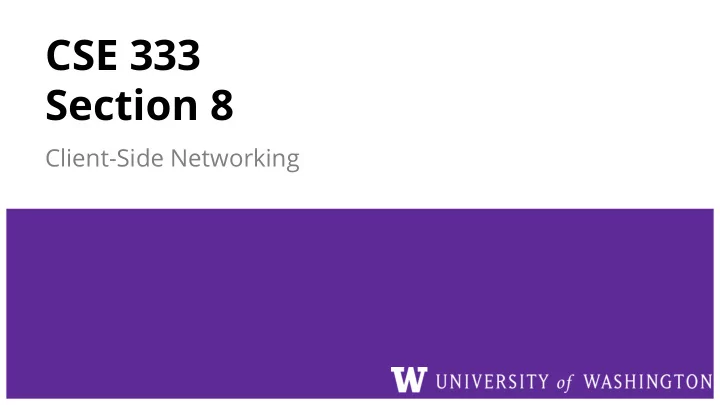

CSE 333 Section 8 Client-Side Networking
Computer Networks: A 7-ish Layer Cake format/meaning of messages sending data end-to-end routing of packets across networks multiple computers on a local network bit encoding at signal level
Exercises 1 & 2
Exercises 1 & 2 format/meaning of messages sending data end-to-end routing of packets across networks multiple computers on a local network bit encoding at signal level
Sockets - Just a file descriptor for network communication - Types of Sockets - Stream sockets (TCP) - Datagram sockets (UDP) - Each socket is associated with a port number and an IP address - Stored in network byte order (big endian)
Sockets struct sockaddr (pointer to this struct is used as parameter type in system calls) fam ???? .... struct sockaddr_in (IPv4) fam port addr zero 16 struct sockaddr_in6 (IPv6) fam port flow addr scope 28 struct sockaddr_storage fam Big enough to hold either
Big Endian and Little Endian - N etwork Byte Order (Big Endian) - The most significant byte is stored in the highest address - H ost byte order - Might be big or little endian, depending on the hardware - To convert between orderings, we can use - uint32_t htonl (uint32_t hostlong); - uint32_t ntohl (uint32_t hostlong);
Exercise 3
1.
int getaddrinfo(const char *hostname, 1. getaddrinfo() const char *service, const struct addrinfo *hints, struct addrinfo **res); - Performs a DNS Lookup for a hostname
int getaddrinfo(const char *hostname, 1. getaddrinfo() const char *service, const struct addrinfo *hints, struct addrinfo **res); - Performs a DNS Lookup for a hostname - Use “hints” to specify constraints ( struct addrinfo * ) - Get back a linked list of struct addrinfo results
1. getaddrinfo() - Interpreting Results struct addrinfo { int ai_flags; // additional flags int ai_family; // AF_INET, AF_INET6, AF_UNSPEC int ai_socktype; // SOCK_STREAM, SOCK_DGRAM, 0 int ai_protocol; // IPPROTO_TCP, IPPROTO_UDP, 0 size_t ai_addrlen; // length of socket addr in bytes struct sockaddr* ai_addr; // pointer to socket addr char* ai_canonname; // canonical name struct addrinfo* ai_next; // can form a linked list }; - ai_addr points to a struct sockaddr describing the socket address
1. getaddrinfo() - Interpreting Results With a struct sockaddr* : - The field sa_family describes if it is IPv4 or IPv6 - Cast to struct sockaddr_in* (v4) or struct sockaddr_in6* (v6) to access/modify specific fields - Create a struct sockaddr_storage to make a space big enough for either
2.
int socket(int domain, // AF_INET, AF_INET6 2. socket() int type, // SOCK_STREAM (TCP) int protocol); // 0 - Creates a “raw” socket, ready to be bound - Returns file descriptor ( sockfd ) on success, -1 on failure
3.
int connect (int sockfd, // from 2 3. connect() const struct sockaddr *serv_addr, // from 1 socklen_t addrlen) ; // size of serv_addr - Connects an available socket to a specified address - Returns 0 on success, -1 on failure
int connect (int sockfd, // from 2 3. connect() const struct sockaddr *serv_addr, // from 1 socklen_t addrlen) ; // size of serv_addr - Connects an available socket to a specified address - Returns 0 on success, -1 on failure Cast sockaddr_storage* to sockaddr* !
4. read/write and 5. close - Thanks to the file descriptor abstraction, use as normal! - read from and write to a buffer, the OS will take care of sending/receiving data across the network - Make sure to close the fd afuerward
Recommend
More recommend